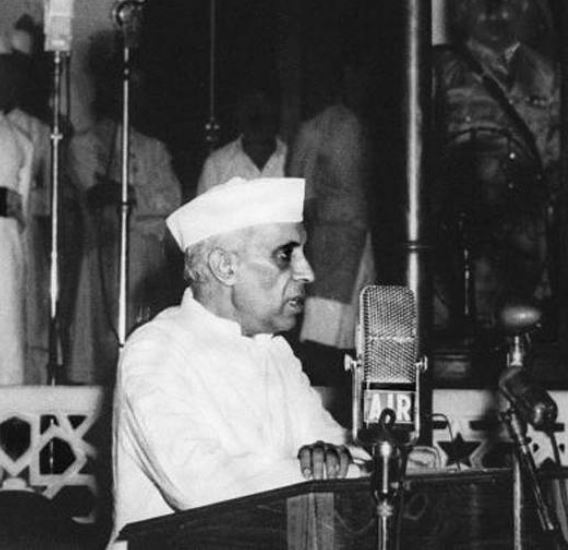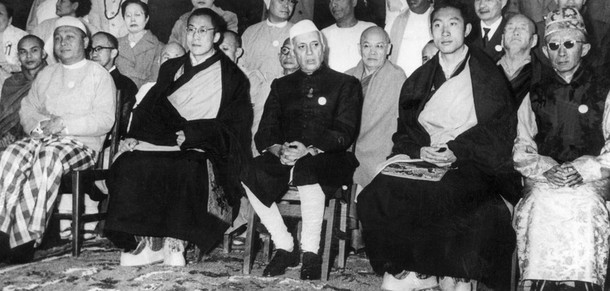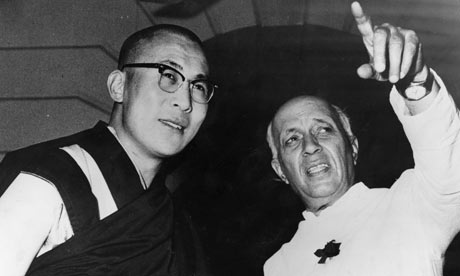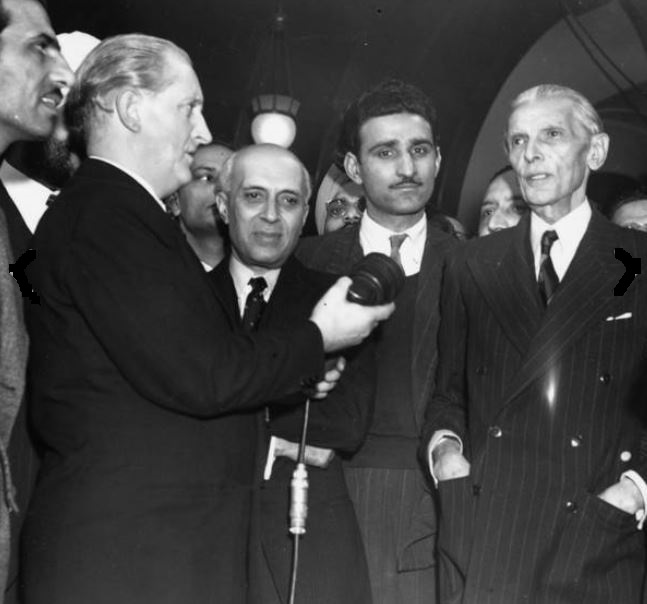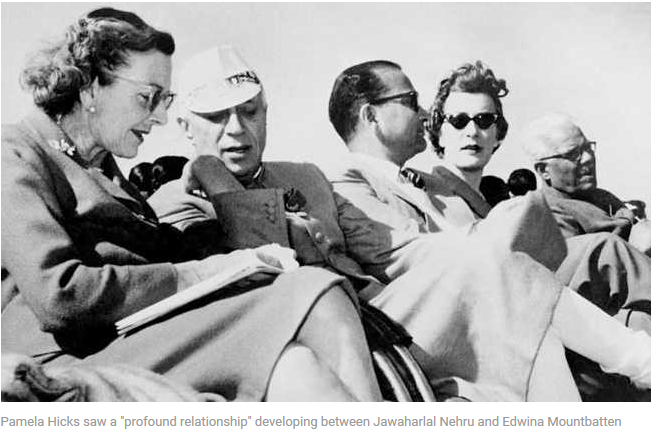Pt Jawaharlal Nehru
This page is under construction
Contents |
China
Nehru did not trust the Chinese
Diplomat G Parthasarathi’s notes claim that Indira Gandhi and Deng Xiaoping reached a pact that was ‘sabotaged’
Contrary to the prevalent perception, India’s first Prime Minister Jawaharlal Nehru was neither soft on China nor trusting of the Chinese. In fact, long before the Sino-Indian war of 1962, Nehru dealt with China only through trusted aides who were sworn to secrecy and bound to communicating with him alone. Nehru was particular that his Defence Minister V K Krishna Menon should not get so much as a whiff of what was going on (vis-à-vis the Chinese), and explicitly said so to his aides.
This is revealed in a new book on G Parthasarathi, the multifaceted diplomat and policy advisor to Prime Minister Indira Gandhi, who had also served under Jawaharlal Nehru and Rajiv Gandhi. Nehru sent GP, as he was known, as India’s ambassador to China in 1958.
Securing border with China
Nehru was torn between loving Chinese civilisation & securing Indian border
Tansen Sen
Jawaharlal Nehru's first noteworthy encounter with the Chinese took place at the World Congress of Oppressed Peoples held in Brussels in 1927. The Chinese representatives, which included Sun Yat-sen's wife Soong Ching-ling, greatly impressed Nehru. Influenced by a new pan-Asianist discourse he started forming his views about a civilisational affinity between India and China.
He frequently voiced his sympathies for the Chinese fighting against invading Japanese forces and initiated a medical mission to China that included Dwarkanath Kotnis. He was a key patron of Cheena Bhavan in Shantiniketan and also saw great potential in developing trade and industrial relations; strongly advocating, for example, commerce through the newly built Burma Road.
The watershed moment in Nehru's relationship with China came at the Asian Relations Conference in Delhi in March-April 1947, where differences between India and China on Tibet became apparent when the organising committee invited Tibet as an independent country. China launched a strong protest with the interim Indian government. Chiang Kai-shek only agreed to send a delegation after Nehru assured the Chinese that the conference would deal primarily with cultural and economic matters, and that Tibet's status would not be raised.
Nehru's assurances were questioned, however, when the Chinese delegation found a map of Asia depicting Tibet as a separate country and the Tibetan flag displayed at the Conference. The Chinese threatened to withdraw and never trusted Nehru again.
In November-December 1949, the former Kuomintang ambassador in Delhi Lo Chia-lun sug gested to Chiang Kai-shek that the Indian PM might recognise the newly-established Communist regime in China in exchange for their acceptance of the 1914 Simla Agreement. However, the Communist regime was distrustful of Nehru, describing him as a “stooge“ and “running dog“ of British and American imperialists.
During the 1950s Nehru was torn between his love for Chinese civilisation, his empathy towards the Tibetan people, and the need to secure Indian territories. Further, Nehru did not heed Sardar Patel's warning in 1950 about the implications of future Chinese military expansion into Tibet.
Perhaps through the rhetoric of a bhai-bhai relationship, the Panchsheel Agreement of 1954 recognising Tibet as a region of China, and the handholding of Zhou Enlai at the 1955 Bandung Conference, Nehru hoped to convince China of India's stand on border areas. He may even have thought that the dual track of rhetoric and the so-called “forward policy“ were conducive. Indeed, he remained committed to a peaceful relationship, unwaveringly supporting the PRC's entry into the United Nations.
In this context, his decision to intern Chinese migrants in India when the relationship between the two countries deteriorated in 1959 cannot be comprehend ed. The punitive actions against the “Chinese Indians“ suggest an acknowledgement of agonising failure.In 1943, in jail, Nehru wrote, “What is there that draws China to India and India to China?
Something in our subconscious racial selves? Some forgotten memories of a thousand years ago? Or just common misfor tune?“ Right after jotting these lines, he added, “wishful thinking“. These two words must have echoed repeatedly as Nehru tried to come to terms with geopolitical realities ex posed by the 1962 war.
Canards about Nehru
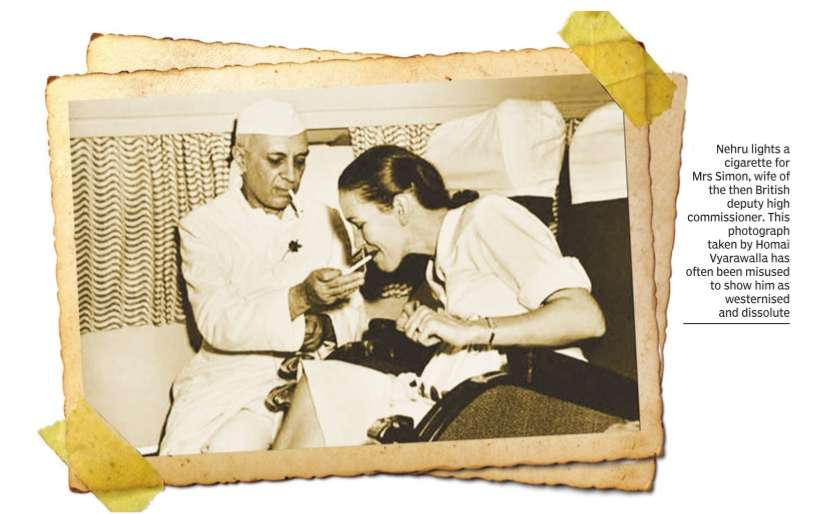

Canards about Nehru
Edwina Mountbatten
‘Edwina, Nehru never alone to be lovers’
My Mother Found 'Companionship' In Pandit Nehru: Mountbatten's Daughter|July 30, 2017
Jawaharlal Nehru and Edwina Mountbatten loved and respected each other but their relationship was never physical as they were never alone, says the daughter of India's last vicereine.
Pamela Hicks nee Mountbatten was 17 when her father Lord Louis Mountbatten came to India as the last Viceroy. She saw a "profound relationship" developing between Nehru and her mother Edwina Ashley.
"She found in Panditji the companionship and equality of spirit and intellect that she craved," Pamela says. Pamela was keen to know more about the relationship.
But after reading Nehru's inner thoughts and feelings for her mother in his letters, Pamela "came to realise how deeply he and my mother loved and respected each other".
Pamela says she had been "curious as to whether or not their affair had been sexual in nature" but after having read the letters, she was utterly convinced it hadn't been.
"Quite apart from the fact that neither my mother nor Panditji had time to indulge in a physical affair, they were rarely alone. They were always surrounded by staff, police and other people," Pamela writes in "Daughter of Empire: Life as a Mountbatten".
The book, first published in the UK in 2012, has been brought out in India as a paperback by Hachette.
Lord Mountbatten's ADC Freddie Burnaby Atkins also told Pamela later that it would have been impossible for Nehru and Edwina to have been having an affair, such was the very public nature of their lives.
Pamela also writes that while leaving India, Edwina wanted to give Nehru her emerald ring.
"But she knew he would not accept it. Instead, she handed it to his daughter, Indira, telling her that if he were ever to find himself in financial difficulties - he was well known for giving away all his money - she should sell it for him," the book says.
At a farewell party for the Mountbattens, Nehru said while addressing Edwina directly, "Wherever you have gone, you have brought solace, you have brought hope and encouragement.
Is it surprising, therefore, that the people of India should love you and look up to you as one of themselves and should grieve that you are going?"
Details
Yashee, November 16, 2022: The Indian Express

From: Yashee, November 16, 2022: The Indian Express
The ties between Nehru and the Mountbatten couple, which their daughter Pamela described as a “happy three-some”, has been dealt with at great length in various books, including Alex von Tunzelmann’s ‘Indian Summer’ (2007). The picture that emerges is of a relationship of deep love and respect, and one that cast an indelible imprint on how independent India took shape.
How they came close
In May 1947, Jawaharlal Nehru was invited to Mashobra in Simla by Viceroy Lord Louis Mountbatten and Lady Edwina Mountbatten for an ‘informal weekend’.
Tunzelmann writes that initially, Nehru was tense, but soon, he relaxed.
“Jawahar walked with Dickie and Edwina around the orchard terraces and up mountain paths, which wound up the hill from which Lord Kitchener’s former mansion, Wildflower Hall, could be glimpsed atop the next peak. Though once a flamboyant youth, Nehru had become a man of simpler tastes. Yet there were two pleasures he could never resist: the vitality of mountain scenery, and the company of an interesting woman. At Mashobra, he had both. Soon he was happily teaching Dickie and Edwina to walk backwards up slopes to rest their muscles…”
Yet, more happened at Mashobra than the first significant meeting between Nehru and Edwina. This was the visit where Mountbatten showed Nehru the transfer of power plan, and an enraged Nehru shot off a “bombshell letter”, rejecting many points of the plan.
The Mountbattens’ younger daughter, Lady Pamela Hicks, writes in her book ‘India Remembered: A Personal Account of the Mountbattens During the Transfer of Power’ (2007), “… my father began soul-searching and decided to show Nehru the Mountbatten Plan to get his feedback. Nehru was incandescent and kept Krishna Menon up till dawn the night that he arrived, dictating the bombshell letter dated the 11th May (1947) to my father which rejected many points of the plan which he saw as the Balkanisation of his country. My father rethought and with the incredible Menon, redrafted the whole plan…,”
About the same incident, Tunzelmann writes, “So well had things been going with Jawahar that, on a whim Dickie broke protocol and ignored the advice of his staff to show his new chum a copy of the secret plan in the study after dinner that very night. But when Jawahar read through the top secret papers his disposition turned from affable to shocked, and from shocked to furious.
At two o’clock the next morning he stormed into Krishna Menon’s bedroom. The draft proposals, he wrote to Dickie that night, ‘produced a devastating effect upon me.’ They presented, he said, ‘a picture of fragmentation and conflict and disorder, and, unhappily also, of a worsening of relations between India and Britain.'”
Mountbatten took note of Nehru’s objections, and the plan was smoothened into a “acceptable shape”, where Edwina “extracted a concession” from Nehru to offset some revisions to the plan.
The relationship and Jinnah
Muhammad Ali Jinnah’s knowledge or suspicion that Nehru was shown the draft plan would go on to influence his attitude to Lord Mountbatten and his proposals — Tunzelmann says Jinnah had strong reasons to suspect Mountbatten was “wrapped around Nehru’s finger”. However, according to Tunzelmann, Jinnah was once brought too close for comfort to the Edwina-Jawaharlal dynamic. She writes that according to SS Pirzada, later foreign minister of Pakistan, in June 1947, Jinnah was handed some letters purportedly written by Edwina to Nehru.
“ Pirzada claimed that Jinnah discussed what to do about these letters with Fatima [his sister] and his colleagues. In the end, Jinnah concluded Caesar’s wife should be above suspicion’, and had the letters returned.”
After independence
After Nehru’s political mentor and guru, Mahatma Gandhi, was assassinated, it was Edwina who sat next to a stricken Nehru at the funeral. Their relationship became closer.
“In those days of tension, and later when she [Edwina] came to stay with my brother after he became Prime Minister of the Republic of India, she was one of the few people left who could break his sombre moods, remembered Jawahar’s sister, Betty. “When she was there, Bhai’s laughter would ring through the house as it used to when we were young.”
Dickie [Lord Mountbatten] showed no sign of feeling excluded by the relationship. He pasted into his own private photograph album a selection of pictures from early February, when he and Edwina went to the Kumbh Mela at Allahabad with Jawahar… One snapshot of Dickie, Edwina, Jawahar and Pamela was captioned simply, in Dickie’s handwriting, ‘Family visit to Allahabad’,” Tunzelmann’s book says.
When Edwina was once taken dangerously ill, she entrusted letters Nehru wrote to her to her husband. She told Lord Mountbatten, “You will realise that they are a mixture of typical Jawaha (sic) letters, full of interest and facts and really historic documents. Some of them have no ‘personal’ remarks at all. Others are love letters in a sense, though you yourself will realise the strange relationship —most of it spiritual — which exists between us. J has obviously meant a very great deal in my life in these last years and I think I, in his. Our meetings have been rare and always fleeting but I think I understand him, and perhaps he me, as well as any human beings can ever understand each other.”
In her book, Pamela quotes a letter which Lord Mountbatten wrote to her elder sister Patricia in June 1948: “She [Edwina] and Jawaharlal (sic) are so sweet together, they really dote on each other in the nicest way and Pammy and I are doing everything we can to be tactful and help. Mummy has been incredibly sweet lately and we’ve been such a happy family.”
When Edwina, as Countess Mountbatten, died in 1960 in Indonesia, a pile of letters were found at her bedside table — they were all from Jawaharlal Nehru.
Foreign relations
1950- 51: Schism on refugee and Pakistan policy
Nalin Mehta, Dec 20, 2021: The Times of India
Jawaharlal Nehru is a hate figure for the Hindu right today because of his indelible stamp on India’s early direction — one that Hindu traditionalists did not agree with — in the first 17 years after Independence, when he was India’s first Prime Minister and undisputed Congress supremo. Yet, Nehru’s supremacy within the Congress was not preordained. In the first two years of his premiership, he faced such a challenge from Hindu traditionalists within his own Congress party, who were unhappy with his policies on Pakistan and Hindu refugees, that Nehru was forced to resign.
The dispute started when Syama Prasad Mookerjee, Hindu nationalist ideologue, India’s first minister for industries and later founder of the Akhil Bharatiya Jan Sangh, which preceded the BJP, resigned from Nehru’s cabinet. He quit the Nehru government over the protection of Hindus left behind in East Pakistan, specifically protesting the Nehru-Liaquat Delhi pact. Under the Delhi pact on migrations between East Pakistan and West Bengal, jointly signed by Nehru and Pakistan Prime Minister Liaquat Ali Khan on April 8, 1950, both governments agreed to guarantee the safety of religious minorities on their side. Mookerjee, along with another cabinet minister, MC Neogy, resigned from the government in protest the day that Khan was slated to arrive in Delhi.
He argued that Pakistani assurances on minority rights were untrustworthy since it was now an Islamic state. He felt that Nehru had acted weakly on the migrant question and went so far as to imply a military solution to protect Hindu minorities—whom he saw as the remnants of the Hindu nation—in East Pakistan. Rather than trusting Pakistan, Mookerjee felt ‘it would be better to propose an outright exchange of population’, because it was feared Hindus had ‘lost all sense of security in Eastern Pakistan’.
Nehru’s response was based on a different idea of the nature and function of the Indian state, ‘even when those principles were unpopular with the masses’. He told Parliament that ‘protection in Pakistan can only be given by Pakistan. We cannot give protection in Pakistan.’ He argued, ‘There is no other way. So long as there is a government dealing with a situation [on Hindu minorities], you have to deal through that government.’ For Nehru, as the political historian BD Graham summed it up, ‘India could not interfere in the internal affairs of another polity, in this case Pakistan, even when the question at issue was the future of Pakistan’s Hindu minorities’. For Mookerjee, ‘the mere fact that that they were Hindus was sufficient justification for India’s taking action’. A Hindu anywhere, in this conception, was India’s concern. More so if they were in Pakistan.
These disagreements and Mookerjee’s exit from Nehru’s government created a deep schism within the Congress. Mookerjee had, as an early historian of the Jan Sangh noted, ‘acted out what many Congressmen would have liked to have done themselves’. The dispute on Hindu refugees also led to a bitter internal fight within the ruling Congress—between the Nehruvians and the party’s own Hindu traditionalists. It eventually came to constitute the single biggest threat Nehru faced to his leadership from within his party after Gandhi’s death, until the China war.
Nehru vs Hindu traditionalists within Congress Soon after leaving the Nehru government, Mookerjee attended a large meeting of refugee groups in Delhi on July 29, 1950. He was welcomed at the Old Delhi railway station by crowds of Hindu nationalist young men holding up banners like, ‘We Do Not Want Nehru’s Anti-Hindu and Cowardly Government’ and ‘Nehru-Liaquat Pact Murdabad’(Death to the Nehru-Liaquat Pact). The anti-Nehru tenor of the conference, which brought together 5,000 delegates and 15,000 visitors from across the country, could not be clearer. Yet, Purshottam Das Tandon, a close confidant of Deputy Prime Minister Sardar Vallabhbhai Patel, chose to ‘preside’ over the refugee conference. In a 90 minute speech, he made it clear that the Nehru–Liaquat pact had ‘failed to stop the migration of Hindus’ from East Pakistan. ‘Reports of dacoities in Hindu homes, molestation of women’ and ‘requisitioning of Hindu houses’ were received ‘even after the Pact’, he added. This was precisely why Mookerjee had walked out of Nehru’s government. Now a major Congress leader was publicly challenging the Prime Minister’s flagship initiative. The conference concluded with a resolution on the ‘Indo-Pakistan Agreement’, which declared that Pakistan had failed to implement the Delhi Pact in its territory.
Within two months, the 68-year-old Tandon defeated JB Kripalani, better known as Acharya Kripalani, in a contest for Congress presidency at the party’s Nagpur session on September 2, 1950. Tandon’s victory, by 1,306 of 2,618 votes, showed how deeply divided the Congress was on Nehru’s refugee and Pakistan policy. The victory was construed in Congress circles as the ‘most significant pointer to the government as to the direction in which popular opinion in the country would like their policies and programmes to be reoriented in the coming years, particularly in regard to Indo-Pakistan relations, rehabilitation of refugees, propagation of Hindi and development of cottage industries’. Kripalani later said that Patel had personally called several Congress chief ministers and solicited their support for Tandon’s election. Nehru, on the other hand, reportedly wrote a letter on the eve of the election to G Ramachandran in which he ‘strongly disapproved Tandon’s candidature’.
When Tandon won, Nehru saw the election result for what it was: a direct challenge to his writ by the Hindu traditionalist wing of the Congress. ‘Communal and reactionary forces had openly expressed their joy at the result,’ he responded in a bitter public statement, demanding a mandate for his policies from his party at its upcoming Nasik session on September 20-21, 1950. The importance of this showdown can be gauged by how Tandon framed it on his way to Nasik. Speaking to reporters at Jhansi railway station, Tandon declared that he and other party leaders were ‘going to Nasik to decide finally the question of whether the Congress must live or die at this stage’ [emphasis added]. The fact that this statement was uttered in the presence of another Hindu traditionalist, UP chief minister Govind Ballabh Pant, underscored the nature of the rift. Another UP Congress leader put this in context, saying that ‘contradictions within the Congress, artificially suppressed so far’, between the forces of ‘reaction and progress’ were now coming to a head.
As both Nehru and Tandon headed to Nasik for a show of strength, newspapers openly wrote about the possibility of a ‘split’ in the Congress, which in turn could ‘possibly result in another exodus of Muslims from India and accelerate the migration of Hindus from Pakistan’. Interestingly, Tandon seems to have met both Nehru and Patel after his election to have a ‘free and frank exchange of views’ on Nehru’s policies. Old friends from UP, now divided by ideas, Nehru and Tandon had agreed to continue working together. Yet, the divide was so deep that the possibility of Nehru resigning from the government and the Congress Working Committee was discussed in these meetings. The prime minister had been persuaded not to do so for the moment, but a newspaper reported that he had ‘not made up his mind’ on resigning.
Amidst a heavy downpour that practically turned the Nasik meeting into a swamp, Nehru took the stage. He went straight for the jugular: a threat to resign. ‘I am prime minister,’ he told the Congress’s delegates, ‘because you have chosen me.’ As he put it: If you want me as Prime Minister you have to follow my lead unequivocally. If you do not want me as Prime Minister, you tell me so and I shall go. I will not hesitate. I will not argue. I will go out and fight for the ideals of the Congress as I have done all these years. Speaking specifically on the ‘Hindu-Muslim’ refugee question and the internal party critique of his policies, Nehru drew a distinction between democratic principles and mob rule. The bottomline was that he was not prepared ‘to accept for a single moment the theory trotted out by certain sections of Congressmen and others that democracy means that whatever people feel regarding any matter is to be accepted.’ The prime minister thundered: ‘If that is called democracy then I say, hell with such a democracy.’ And then he questioned, ‘What has happened to the minds of Congressmen? Do they want today to bow before what a mob says and compromise their principles?... I do not agree that Congressmen should do what the large majority of people ask to be done.’ Nehru’s emotional and hard-hitting speech won him a standing ovation. The same Congress leaders who earlier that month had voted Tandon in, passed Nehru’s ‘Resolution on Communalism’ with an overwhelming majority. At least one newspaper noted that Sardar Patel had sat in silence through the entire proceedings as Nehru’s resolutions got passed. The Sardar’s ‘complete silence’ was ‘much commented upon’, but ‘perhaps there was nothing to it apart from his ill health’.
Nehru’s speech won him the immediate battle, but tensions between the ‘secularists’ and the ‘Hindu nationalists’ continued to simmer. He left Nasik with a ‘disturbing suspicion’ that, while his party-men may have been shamed into siding with him, they may not really have bought his argument. He was ‘deeply troubled,’ he said, by a ‘feeling of different pools in the country and different pools and ideas within the Congress’. The Congress’s Hindu traditionalists hit back within a year by forcing Communications Minister Rafi Ahmad Kidwai’s exit from Nehru’s cabinet on August 2, 1951. Kidwai, a key Nehru confidant, resigned as a Union government minister after months of feeling sidelined in internal party decision-making by Tandon and his group, whom he accused of working in an “undemocratic manner" against the principles of the Congress. In a strong statement against the Congress president, Kidwai publicly asked, ‘Is there a parallel in the world where the executive head i.e. the President of an organisation is the very antithesis of everything that the organisation stands for? What is there in common between Shri Purshottamdas Tandon and the policies of the Congress—economic, communal, international and on refugees?’. This was when Nehru decided to take the bull by the horns.
In a sudden ‘bombshell’ move, the prime minister formally resigned from the Congress Working Committee and the party’s Central Election Board. This was the first time he had ever done so. It was also the last. He was throwing down the gauntlet. A full year of ‘controversy between him and the Congress president’ led to this ultimatum on 7 August 1951. The PM had spent a year in bruising battles with the Hindu traditionalists, but he was now in a stronger position within his party. Patel’s death in December 1950 had also deprived the Hindu traditionalists of a powerful supporter.
By resigning, Nehru had forced the party’s hand. He first won a vote of confidence in the Congress Parliamentary Party on 21 August. By September 8, he was also elected Congress president, forcing Tandon to resign from the position. Independent India’s first election was just a month away. With this victory within his own party, Nehru was now ‘monarch of all that he surveys in this country’, as summed up by a newspaper report. It had been nothing short of a battle for the control of the party machinery. The Congress’s Hindu traditionalists agreed with Mookerjee’s critique of Nehru’s Pakistan policy but when push came to shove, they chose not to split the party and failed to oust Nehru. As PM, Nehru had largely ‘kept away’ from organisational matters until his decisions were publicly challenged. It was Patel who had largely managed the party machine until his death. Now, Nehru wrested control.
The bitter war ‘between two forces within Congress—the secular nationalists and the Hindu traditionalists’ was closely watched by both the R S S and the Hindu Mahasabha. ‘Nehru’s victory was by no means certain even as late as August 1951, and until the outcome of the struggle was clear, the Hindu traditionalists hesitated to form a strong party to challenge the party,’ Graham observed. If Nehru had lost the leadership, it is not inconceivable that both Mookerjee and the R S S would have been comfortable with a Congress that could have turned Hindu nationalist. Nehru’s triumph meant that such an option was out of reach. The Jan Sangh had become inevitable: it was launched nationally the very next month.
China
Indulgent approach?
Indrani Bagchi, August 2, 2021: The Times of India
NEW DELHI: Was Nehru too indulgent of China to work out a sensible policy on Tibet and on the border question? Was he misguided? Or were Indian diplomats merely poorly prepared, which led to not only a disastrous war with China but also an intractable border question. Two new books by former foreign service officers, Avtar Singh Bhasin and former foreign secretary Vijay Gokhale delve into the details of India's policies towards China.
Bhasin’s latest book, “Nehru, Tibet and China” using official documents, shows the bumbling and naivete that accompanied Indian policymaking on Tibet and China in the run-up to 1962. Speaking to TOI about Nehru’s campaign to get China a UNSC membership, Avtar Singh Bhasin said, “In the early years that India went out of its way to woo China for the larger objective of achieving Asian solidarity. No threat was as yet perceived from it. Nehru’s desire for China to replace Kuomintang China in the UN Security Council reflected his sense of fairness, since communist China controlled the whole mainland and India too had recognised it.”
If, in the UN, Nehru was intent on getting China into the UNSC, on the other side, India appeared unprepared and reluctant in their boundary negotiations with China. Bhasin says, India “somehow felt that the talks would not lead to any results. Nehru had even told Premier Zhou before the talks that ‘respective view points of our two governments ...were so wide apart and opposed to each other that there was little ground left for useful talks’. A week before the talks began, he had taken the Nepalese prime minister into confidence at the prospects of the talks, and said ‘as far as I can see, there will be no real approach to any kind of agreement between India and China in the course of my meeting with Premier Chou En lai next week’. Evidently India’s half-hearted approach did not help. The border dispute leading to the possibility of conflict remained present.”
In his masterful account, The Long Game: How China Negotiates with India”, former foreign secretary, Vijay Gokhale, writes that Nehru accepted Zhou En Lai’s proposal to convert the Indian mission in Lhasa into a consular post “without apparently realizing either its legal of political implications.” India, he writes, “went about the negotiations in an ad hoc fashion and without adequate internal consultation, leave alone proper research on facts.” China’s negotiating strategy, on the other hand, was methodical and practical. They “persuaded” India into withdrawing its military escorts from Gyantse and Yadong, leverage he says, India gave up in 1953. “Ignoring inputs from Lhasa that the Chinese were studying all documents relating to the India-China boundary in Tibet, a policy note from the prime minister on 3 December 1953 decided once and for all that the question of the frontier would not be raised or discussed during the forthcoming India-China talks about Tibet, because it was already a settled issue.”
India, he writes, brought more pressure on itself by becoming anxious about concluding a settlement before the Geneva Conference began in May 1954… the primary consideration for this was not national security but India’s international image.” China stretched out the negotiations, forcing more Indian concessions.
Bhasin writes about India glossing over the importance of China’s road-building exercise in Aksai Chin in the 1950s. Talking about it, he says, “If we look at Nehru’s attitude towards China at this time, he appeared too indulgent towards it. His note to the defence minister KN Katju on 28 July 1956 says it all. He had said that he was more worried about the Naga trouble... ‘than about anything the Chinese may do’. In his perception the Chinese were friends and he expected no trouble from them. Even when making a “protest” on the road, the wording of the note was so weird that it lacked even an iota of seriousness giving the Chinese impression that India was not seriously concerned about their road.”
Are there any lessons India of 2021 can learn from Nehru’s dealings with China in the 1950s and 1960s? Bhasin says, “The situation over the years has become too complicated. The past has ceased to be relevant to the present. In my opinion, the people need to be educated of the correct position of the borders that existed in the past so that the vested interest, which indulges in motivated debates and leaves the T.V driven public more confused than ever, making the settlement of even smaller issues impossible, are enabled to take an informed and independent view of the situation. A people fully armed with facts are an asset otherwise they are a liability and force the government’s hands into directions that often are unwarranted. Throw open all the archives and let the truth come out.”
Hinduness
Sudheendra Kulkarni’s evidence
Sudheendra Kulkarni, April 20, 2023: The Indian Express
A friend of mine, who teaches at a Delhi college, said the BJP’s centralised system of social media communication is super-efficient in spreading misinformation. “A message sent from Delhi goes viral nationwide through thousands of WhatsApp groups.” For example, he said, “I once asked people in my village in Bihar to name the leader who is supposed to have said ‘I am an Englishman by education, Muslim by culture and Hindu only by accident’. Pat came the answer: ‘Nehru.’”
The Hindu Mahasabha, a foe of India’s first prime minister, first popularised this line in 1950 — “Nehru is an Englishman by education, Muslim by culture and Hindu only by accident.” Subsequently, his haters attributed it to him so as to make it sound authentic. The deliberate misattribution received renewed traction when Uttar Pradesh chief minister Yogi Adityanath, speaking at an election rally early last year, took a dig at Rahul Gandhi saying, “People whose ancestors called themselves ‘accidental Hindus’ cannot call themselves Hindus.”
Prime Minister Narendra Modi’s followers have mounted a systematic campaign to project Jawaharlal Nehru as someone who was not only a non-Hindu but also anti-Hindu. Maligning his sterling contribution to India’s freedom struggle and to the building of a modern India in the post-1947 era is one part of this campaign. The other is to erase his name from national memory. In the official celebration of the 75th anniversary of India’s Independence, images of our longest-serving prime minister were mostly missing. In comparison, Sardar Patel and Savarkar received far greater prominence.
But was Nehru really anti-Hindu? Any truthful study of his life would expose this canard. Each of his three seminal books — Glimpses of World History (1934), An Autobiography (1936), The Discovery of India (1946) — is a classic, written when he was in jail. (Imprisoned 14 times by the British, he spent 3,259 days behind bars.) And all his works, including the voluminous collection of his speeches, articles and letters (his fortnightly letters to chief ministers alone fill five thick volumes) are filled with his deep pride in the universal and integrationist character of India’s ancient Hindu civilisation, which he believed was enriched by Islam and other external influences.
His writings offer a flood of evidence of his love and reverence for the Ramayana, Mahabharata and Bhagavad Gita; for the wisdom of our rishis in the Vedas, Upanishads and other scriptures; for the richness of Sanskrit language; for all the saints, poets and social reformers of the Bhakti era; and for Ramakrishna Paramahamsa, Swami Vivekananda, Maharshi Aurobindo and other great exponents of Hindu philosophy who contributed to national awakening in modern times. His abiding respect for his mentor Mahatma Gandhi, whose principal source of guidance were the teachings of Hinduism, is well known.
Nehru was not a temple-hopping Hindu. But he had profound interest in Hindu spirituality and mysticism, which intensified as he grew older. His description of the Himalayas and Ganga, which he regarded as the cradles of Indian civilisation, moves us with its divine romanticism. He was a devotee of Mata Anandamayi, who was also revered by his wife Kamala and daughter Indira. S Radhakrishnan, President of India (1962-67) and author of many acclaimed books on Hindu philosophy, has revealed that Nehru, in the last years of his life, used to frequently meet him for discussions on the Upanishads.
Nehru was a man in a hurry to modernise India. “There is, however, another face of Nehru which places him, even if indirectly, among the proponents of Hindu civilisation,” writes Girilal Jain, former chief editor of The Times of India, in his acclaimed book The Hindu Phenomenon. (Incidentally, this book, published in 1994, predicted the BJP’s rise and eclipse of the Congress.) Recurrently extolling the Vedantic view of life, Nehru stressed that material development without moral and spiritual development would be ruinous for humanity. He was not a blind believer in modernisation, and never equated it with westernisation. He wanted India to progress rapidly by mastering modern science and technology, which in his time necessarily had to be learnt from the West. But he was deeply aware of the severe limitations of the violence-inducing western models of development — both capitalist and communist — and their unsuitability to India. He tirelessly emphasised that India must give up outdated customs and traditions such as untouchability, caste discrimination and injustice to women. He was also against the purdah system among Muslim women. Nevertheless, he cautioned against berating everything in Indian culture, which he said was the surest way of becoming rootless.
In this, we can see a remarkable congruence between his worldview and that of some of the leading Hindu thinkers of the R S S and the Jana Sangh in his time. For example, Pandit Deendayal Upadhyaya’s treatise “Integral Humanism”, which the BJP regards as its ideological guide, echoes Nehru’s thinking about eschewing both capitalism and communism, and pursuing an essentially Indian and holistic path of development. Like Nehru, Upadhyaya also advocates pride in what is good in our ancient culture and readiness to root out the bad in it. He writes: “We have taken due note of our ancient culture. But we are no archeologists. We have no intention of becoming the custodians of a vast archeological museum… We shall have to end a number of traditions and set in reforms which are helpful in the development of values and of national unity in our society.”
There were, of course, some serious differences between Nehru and his critics in the R S S, Jana Sangh and pre-Modi BJP. These cannot be glossed over. But there was none of the crude and venomous vilification of Nehru that we see now. When he passed away in May 1964, Atal Bihari Vajpayee paid a rich tribute in Parliament saying “Mother India is in mourning as her beloved Prince has gone to sleep”. Comparing Nehru to Ram, Vajpayee said, “In Panditji’s life, we get a glimpse of the noble sentiments found in the saga of Valmiki”. Like Ram, Nehru was “the orchestrator of the impossible and inconceivable…That strength of personality, that vibrancy and independence of mind, that quality of being able to befriend the opponent and enemy, that gentlemanliness, that greatness − this will not perhaps be found in the future.” ‘Guruji’ Golwalkar, second chief of the R S S, penned a heartfelt homage praising Nehru’s patriotism and lofty idealism and hailing him as a “great son of Mother India”. Once, when Golwalkar was addressing a training camp for R S S swayamsevaks, a participant harshly criticised Nehru. This displeased him so much that he not only reprimanded that Swayamsevak but also asked him to leave the camp immediately. L K Advani often praised Nehru for laying a robust foundation of parliamentary democracy in India. Also, in his blog in 2013, Advani argued that “Nehru’s secularism was based on Hindu foundations”.
Similarly, there is evidence to show that Nehru had begun to reassess the R S S and Jana Sangh after the debacle in China’s war of aggression in 1962, which hastened his demise. In an interaction with a group of journalists a few weeks before his death, a correspondent of The Patriot (a pro-communist newspaper) made a derisive comment on the Jana Sangh, calling it an “anti-national party”. Nehru immediately stopped him with a retort: “No, Jana Sangh is a patriotic party.”
Unfortunately, Nehru’s Hinduness is now forgotten by both the Congress and the Sangh Parivar. Instead, they constantly harp on their mutual differences. They would do well to remember, however, that a unique quality that has sustained Indian civilisation through ages is its ability to achieve samanvay — reconciling the seeming opposites — and creating a new synthesis. In today’s dangerously polarised times, Nehru offers himself as an ideal candidate for such nationally useful samanvay through samvaad (dialogue).
Ideology
Nehru, Iqbal on secularism, nationalism
Nov 6, 2021: The Times of India
Nehru, Iqbal, cricket and the question of Muslim identity
…the illuminating debate that Jawaharlal Nehru engaged in with the poet-philosopher Muhammad Iqbal, who believed that national loyalty was religious rather than territorial. Writing in 1933, after the failed attempt to think about India’s constitutional future at the Round Table Conferences, Iqbal criticised Nehru’s nationalism for its incessant drive to blend India’s divergent communities in a singular whole. Such a fusion, Iqbal cautioned, would always burden existing communities to purge their past and with it their religious particularities. He predicted that this erasure, in turn, would quickly spill over into violence as the old ethical framework of co-existence would evaporate. Pointing to Europe, where he identified secularism and nationalism for having eroded the principles of universal ethics and caused violence on an unprecedented scale during the First World War, Iqbal concluded that large-scale violence would erupt by adopting the same principles in India.
Even if one took Nehru’s India of an inclusive nationalism that accommodated all groups with a government that treated all groups equally, Iqbal found it hard to believe that a Hindu majority would be conducive to an egalitarian ideal. With Hinduism fractured along multiple lines of caste, creed and language, he thought it more likely that a Hindu oligarchy would put on the garb of democracy to push through a majoritarian agenda. Strengthening a Muslim political identity could serve as an antidote, in Iqbal’s eyes, to his gloomy prediction of a future Indian Republic — because it axiomatically entailed the syncretic ethical ideals that had made the co-habitation of Hindus and Muslims on the Indian subcontinent possible. For Iqbal, the attempt to overcome religion through secularism or socialism would necessarily splinter the subcontinent along religious lines and trigger a civil war.
Nehru remained unconvinced, partly due to his general disdain of religion and his reluctance to mix religion with politics. Nehru saw religion as a diversion from the far worthier goal of economically uplifting India’s poor masses. Iqbal’s concrete suggestion of how a Muslim community could be safeguarded through constitutional reform only fuelled Nehru’s doubts further. Iqbal had proposed that the colonial government should constitutionally exclude the Ahmadiyya, a tiny Muslim reformist movement, as he saw them violating the integrity of Islam through their theological beliefs. For Nehru, following this debate from Almora jail, inviting the colonial government to step into the terrain of religion — to define who was or was not a Muslim — appeared like a path for religious conservatism to employ constitutional means to shield itself from critique and reform.
Nehru worried that if Iqbal’s proposal for constitutional exclusion of this Muslim sect was implemented, then demands of orthodox Hindus to shield Hinduism from much-needed social reform efforts would be next on the agenda. A pan-orthodox resistance against progressive reforms, for instance, fixing the age of marriage for girls to 14 in 1929 in the so-called Sarda Act, had already alerted Nehru that the conservative faction had a large spectrum of political overlap.
Both Nehru and Iqbal were partly right in their prediction of India’s future. Nehru foresaw that following Iqbal’s suggestions for constitutional transformation to preserve religious doctrines would kickstart a cycle of “heresy hunts, ex-communication, punishment for apostasy, and a general suppression”. On the other hand, Iqbal may have raised a valid point that secular nationalism of the Nehruvian variety would ultimately fail to satisfy India’s minorities — or indeed its other communities either. Instead, it would lead to continuous bouts of violence and eventually, for better or worse, to separation.
Tripurdaman Singh and Adeel Hussain are co-authors of the forthcoming book Nehru: The Debates that Defined India
Personal life
Budhni Manjhiyain, his “tribal wife”
Anil Ashutosh TNN, Nov 21, 2023: The Times of India
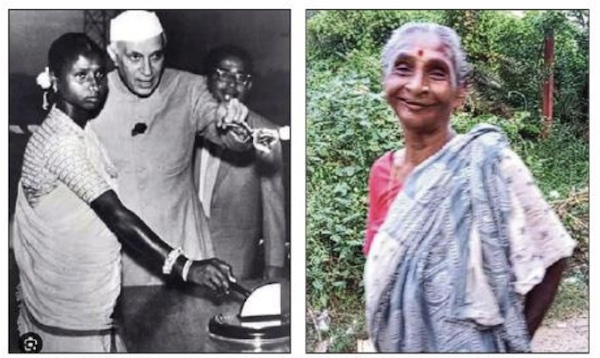
From: Anil Ashutosh TNN, Nov 21, 2023: The Times of India
Dhanbad : Calls have rung out from a Jharkhand pocket for a monument to “Nehru’s tribal wife”, a Santhali named Budhni Manjhiyain who died three days ago at 80 after being ostracised for years by her tribe as then PM Jawaharlal Nehru had garlanded her at a dam’s inauguration in 1959 when she was 16 and a project worker.
The garland placed respectfully by Nehru at the inauguration of the Panchet Dam — now near Dhanbad — became a millstone for Budhni for much of her life as the Santhal tribals considered the gesture a “marriage” . She became an outcast for “marrying outside her community, particularly a non-tribal”, and was denied entry into her hamlet. The turbulent tale came full circle November 17 when Budhni died in a shack in Panchet where she lived with her daughter Ratna. Hundreds, including local politicians and officials, descended to give a farewell to what many there described as “the first tribal wife of the first PM of the country”. It was then that they sought a memorial in her honour, next to an existing statue of Nehru in a local park. They also demanded pension for Ratna (60).
Bhairav Mandal, the chief of Panchet panchayat, and others have written to the DVC management about the memorial and a house for Ratna in the local DVC colony. DVC is Damodar Valley Corporation, the PSU under which the dam was built and functions. Sumesh Kumar, deputy chief engineer of DVC at Panchet, said no decision on the memorial or the other demands had been taken so far.
Like the devastating Damodar, the eddies of Budhni’s life began in 1952 when her ancestral land was submerged during the construction of the dam. But she managed to stay afloat, becoming one of the first contract labourers in the project as she had no source of income other than land.
Then, at the inauguration on December 5, 1959, troubles started anew with Nehru’s garlanding. The DVC management had selected Budhni along with Ravan Manjhi, a Santhali man, to welcome the Prime Minister. Local lore has it that Budhni pressed the button to get the dam going.
In 1962, Budhni was retrenched along with scores of other DVC contract workers. She moved to Saltora in neighbouring Bengal’s Purulia and toiled as a daily-wager. There, Budhni met Sudhir Dutta, a contract worker in a colliery who gave her shelter and later married her.
After Rajiv Gandhi visited Asansol in Bengal as PM in 1985, a local Congress leader got Budhni to meet him and she narrated her ordeal. After that, Budhni was provided a job in the DVC, from where she retired in 2005.
Local politicians have demanded a memorial for Budhni next to an existing statue of Nehru at a park in Panchet, near Dhanbad
Religion
Scientific, Rational Humanism
Ashok Vohra, August 31, 2019: The Times of India
Many view the agnosticism / atheism of Nehru as a serious shortcoming of his persona. They feel that “the greatest lack in him was his inability to believe in God.” Nehru remained a hardcore rationalist throughout his life. Nehru found the concept of God itself unintelligible and incomprehensible. In The Discovery of India, he said, “I find myself incapable of thinking of a deity or of any unknown supreme power in anthropomorphic terms, and the fact that many people think so is a source of surprise to me. Any idea of a personal god seems very odd to me.”
However, he always wondered about the sway that the concept of God had on the inner craving of humankind, which “brought peace and comfort to innumerable tortured souls”.
Countering the argument of those who upheld the necessity of God, Nehru maintained that, “even if God exists, it may be desirable not to look up to Him or to rely upon Him.” He argued that “too much dependence on supernatural factors may lead, and has often led, to a loss of self-reliance in man.” It would, according to him, ultimately result in “blunting of his (man’s) capacity and creative ability”.
Though Nehru rejected the traditional notion of God, he argued, that, “some reliance on moral, spiritual and idealistic conceptions is necessary,” for without such a belief “we have no anchorage, no objectives or purpose in life.”
Nehru had immense faith in the human spirit that overcomes nature and brings about great human convulsions. He advocated ‘scientific humanism’ – the synthesis of humanism and scientific spirit. Scientific humanism advocated by Nehru “is practical and pragmatic, ethical and social, altruistic and humanitarian. It is governed by a practical idealism for social betterment”.
Scientific humanism treats humanity as its god, and social service as its religion. It recognises the fact that “every culture has certain values attached to it, limited and conditioned by that culture.” It also recognises that human nature is such that “every generation and every people suffer from the illusion that their way of looking at things is the only right way” to knowing and realising the truth to which they accord permanent validity.
Scientific humanism upholds a radically opposite view, namely, that “the values of our present day culture may not be permanent and final; nevertheless, they have an essential importance for us, for they represent the thought and spirit of the age we live in.”
He had almost the ‘devotion of a faith’ in human virtues and his unlimited capacity to struggle and emerge victorious in any kind of adverse situation. The virtues of man which impressed Nehru most, were man’s indomitable and undaunted spirit which seeks to mount higher and higher, his “gallant fight against the elements, his courage that overcomes nature itself, his limitless endurance, his high endeavour and loyalty to comrades and forgetfulness of self, and his good humour in the face of every conceivable misfortune”.
Like Sartre, Nehru, too, upholds the view that man continually accepts the challenges faced by him in achieving the targets and goals chosen by him. “Life,” according to him “is a principle of growth, not of standing still, a continuous becoming, which does not permit static conditions.” For man, life is a long adventure and an opportunity to test his will and worth. He does not rest till goals are reached. From every disappointment and defeat, the spirit of man “emerges with new strength and wider vision”.
